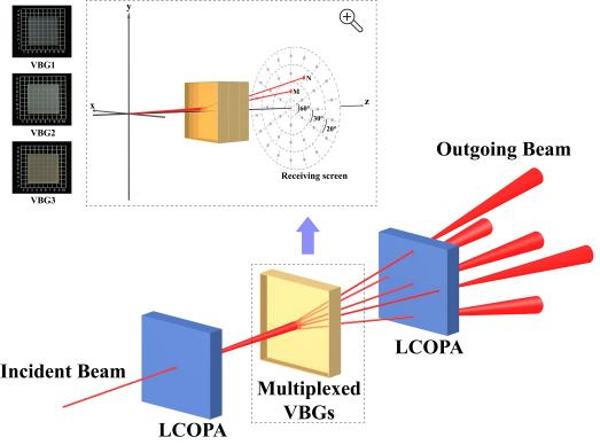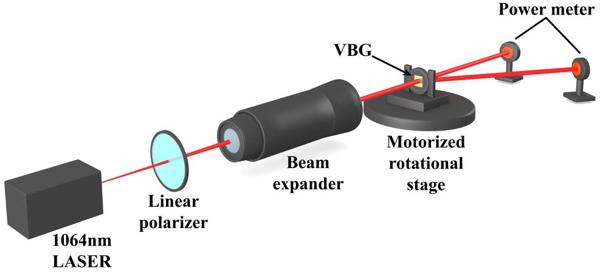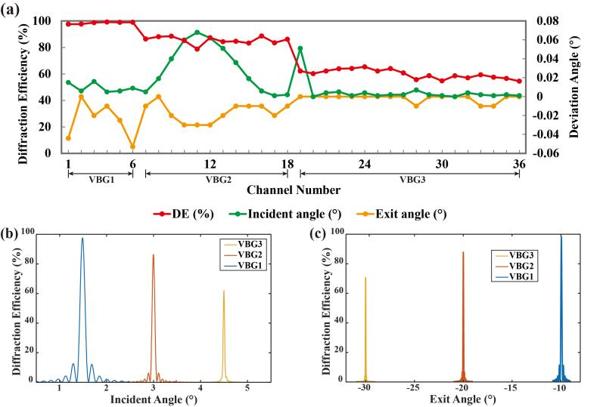The wide-area precise control of laser is a long-standing goal that people have been striving for it. Mechanical beam deflectors, such as Gimbals, fast steering mirrors, Risley prisms and other devices, can meet people's needs in general situations, despite their drawbacks of large mass, large inertia, and easy wear. However, with the miniaturization trend of the scanning system, non-mechanical beam deflectors that are more lightweight and durable are gaining more and more popularity. Currently, non-mechanical deflectors, such as liquid crystal optical phased array (LCOPA), liquid crystal prism, electro-optic deflector, micro-lens array, etc., have been developed with their own unique performance and advantages separately. However, most of them achieve only small-angle deflection. Especially in high-energy laser systems, angle deflectors that withstand hundreds of watts or even kilowatts of power are hard to achieve large-angle beam deflection. For instance, LCOPA could withstand continuous laser irradiation of hundreds of watts, but it exhibits a significant efficiency decline when the deflection angle is too large (±5°). Therefore, using an angle amplifier to magnify the deflection angle becomes an effective solution to cope with the insufficient deflection angle. Volume Bragg grating (VBG) based on photo-thermal refractive glass has good high-power working characteristics, a high damage threshold, and excellent environmental stability. Moreover, it can realize large-angle amplification for multiple incident angles by multiplexing and cascading, making it one of the excellent candidates for angle amplifier.

Fig. 1 Beam scanning system with sandwich structure and volume Bragg grating angle amplifier

Fig. 2 Scheme of diffraction angle and DE measurement of multiplexed VBGs

Fig. 3 (a) DE and deviation angle of each channel. Experimental angle selectivity curves for the incident angle (b) and exit angle (c) of the first channel in each grating.
Recently, the Thin Film Optics Laboratory of Shanghai Institute of Optics and Fine Mechanics proposed an angle amplifier based on peristrophic multiplexed volume Bragg grating (PMVBG) and presented the corresponding channel optimization algorithm for this structure. The related results are published in High Power Laser Science and Engineering (Yuanzhi Dong, Yunxia Jin, Fanyu Kong, Jingyin Zhao, Jianwei Mo, Dongbing He, Jing Sun, Jianda Shao. Angle amplifier in a 2D beam scanning system based on peristrophic multiplexed volume Bragg gratings[J]. High Power Laser Science and Engineering, 2023, 11(1): 01000e13).
Compared with the conventional orthogonal VBG angle amplifier, the introduction of peristrophic multiplexing not only simplifies the design process, but also eliminates the need to optimize the manufacturing process to reduce the performance difference between different channels within a single grating. Figure 1 shows the composition of the whole wide-angle two-dimensional beam scanning system, where the front LCOPA has the function of channel selection, the rear LCOPA is used to precisely control the output angle of the beam, and the angle amplifier is composed of three cascaded PMVBGs. Each grating channel diffracts the incident beam from a small angle to a larger angle, and by peristrophic multiplexing of grating channels, the amplification function is extended from one dimension to two dimensions. In order to achieve continuous angle scanning within the deflection range, a channel number optimization algorithm based on the intersection degree of wave vector sets between channels is proposed, which also calculates the optimal number of grating channels and rotating angle. The designed peristrophic multiplexed volume Bragg grating angle amplifier was fabricated experimentally, and the angle amplification performance of the sample was tested using the device shown in Figure 2. The experimental results are shown in Figure 3, which indicate that the fabricated peristrophic multiplexed volume Bragg grating angle amplifier achieved a two-dimensional full-plane 6-fold angle amplification from ±5° to ±30°, with an angular deviation less than 0.07°, relative diffraction efficiency of all grating channels greater than 55% and root mean square deviation of diffraction efficiency between different channels within a single grating less than 3.4%.
This work shows that the proposed PMVBG angle amplifier has the potential to achieve high-performance, large-angle beam steering in high-energy laser systems. This technology has important potential applications in some fields such as laser radar, free-space laser communication, laser weapons, and laser countermeasures. The research group will continue to optimize the amplification factor, diffraction efficiency, and other aspects to achieve higher performance.


